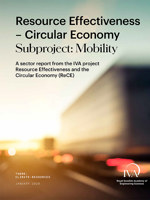Resource Effectiveness – Circular Economy. Subproject: Mobility
Resource use is an existential issue that impacts the climate and biodiversity. We therefore need to avoid unnecessary transport, coordinate necessary transport and increase capacity utilisation and utilisation rates to achieve a climate efficient and resource-effective society. Data sharing is of key importance.
IVA is now publishing action plans for increased resource effectiveness in five resource-intensive areas: mobility, textiles, plastics, facilities and food. This work has been carried out within the IVA project Resource Effectiveness and the Circular Economy, the purpose of which has been to make Sweden more competitive in a future with finite resources in line with the UN’s Sustainable Development Goals.
“The project’s vision is for Sweden to be the leading nation as a resource-effective, circular society,” says Caroline Ankarcrona, Project Manager at IVA.
The project has created platforms for dialogue between representatives from the private and public sectors and academia. They have explored, for example, how Sweden can transition to greater resource effectiveness and a circular economy. The first area addressed is transport and mobility. Here, IVA wants to help resolve the issue of how to meet increased transport needs without using more resources.
“It’s not enough to just transition to fossil-free fuel and electricity. Our freight and passenger transport systems need to be more resource-efficient, otherwise we will not be able to meet future environmental challenges,” says Jan-Eric Sundgren, Chair of the project’s Mobility work group.
The report presents 24 proposals for action. One of the most important areas for action according to the project is ensuring that Sweden moves swiftly to promote secure data sharing for more efficient transport systems. A number of key areas are:
- A national data-sharing strategy to improve transport resource efficiency. The strategy needs to take into account privacy, competition and security. Platforms for neutral and reliable data are needed in each application area.
- Data-sharing can promote combined mobility where people combine public transport with other forms, especially pedestrian and bike traffic.
- The physical infrastructure needs to be planned differently. Transport systems need to be coordinated with common parcel lockers and collection points that are not supplier-specific.
- Data can also be used to increase transport capacity utilisation. Capacity utilisation of load carriers such as pallets and loading cages should be transparent.
